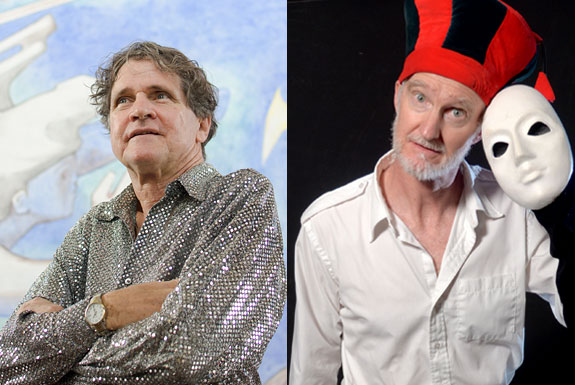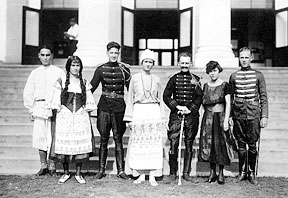Theatre retirees and histories noted
April 19th, 2011 | by Lowell Angell | Published in April 2011, Multimedia | 2 Comments

Departing theatre faculty: Leeward's Paul Cravath and Windward's Ben Moffat
Two University of Hawaiʻi Community Colleges lose longtime, valued theatre faculty this spring—Ben Moffat at Windward and Paul Cravath at Leeward. Both are University of Hawaiʻi alumni with more than two decades on staff. They reflected recently on their careers and programs.
In related pieces on Hawaiʻi’s theatrical history, an online exhibit celebrates early years of drama at UH Mānoa and alumnus (and article author) Lowell Angell publishes a book on historic theatres in the state.
- Ben Moffat: man of masks and monkeys
- Paul Cravath: scholar, actor, producer
- Library exhibit: UH Mānoa’s dramatic history
- New book: historic theatres of Hawaiʻi
 Web extra: Hawaiʻi’s Historic Theatres
Web extra: Hawaiʻi’s Historic Theatres
Ben Moffat: man of masks and monkeys
Windward Community College Professor of Theatre and Chair of Humanities Ben Moffat is proudest of the impact he’s had on individual students’ lives.
Originally from Palo Alto, Calif., he graduated from Vassar College and received his MFA in direction and Asian theatre at the University of Hawaiʻi at Mānoa. He was part of the Mānoa program’s 1986 Beijing opera tour of the People’s Republic of China and recently completed the initiation course at the London International School of Performing Arts.
Since joining Windward as a part-time lecturer in 1987, Moffat built the program from 50–60 students a year to 200 and from four intermittent courses to a fulltime program, earning a UH Regents’ Medal for Excellence in Teaching along the way.
Interested in storytelling using physical theatre, he teaches the Introduction course and acting, mask making and production. His also produces and directs shows and helps manage the theatre.
The Windward program dramatically expanded with the opening of Palikū Theatre in 2002. “We hold classes there as often as 20 times a semester,” he says. “Our students are given two tickets to shows, so they can experience productions first-hand.”
He helped recruit respected drama teacher Ron Bright, who had retired after 50 years of directing the drama program at nearby Castle High School and brings in community groups such as Windward Theatre Guild, The Actors Group, Kumu Kahua, Honolulu Theatre for Youth, ʻŌhiʻa Productions, Loose Screws and Kalāheo High School.
With Monkey Waterfall dance theatre co-artistic director Yukie Shiroma, Moffat has performed around the world, from Spain to Singapore. He leaves Windward this summer for new opportunities, but plans to spend seven months a year performing, writing and doing workshops in Hawaiʻi.
Paul Cravath: scholar, actor, producer
Leeward Community College Professor of Drama Paul Cravath arrived in Hawaiʻi in 1971, Tulane MFA in hand, eager to study Asian theatre. He received his PhD from the University of Hawaiʻi at Mānoa in 1985 and joined Leewardʻs faculty three years later.
Cravath has done research in Cambodia and Bangkok; studied the Indian film industry and aesthetics on a Fulbright grant; and explored ancient Japanese literature, Mandarin Chinese and Khmer. His 2008 book Earth in Flower: The Divine Mystery of the Cambodian Dance Drama is considered the definitive study on the subject in English.
The sense of space and the precision of Asian theatre have greatly influenced his aesthetic and teaching viewpoint, Cravath says. Students responded, fueling a significant increase in program enrollment.
At first he directed Hawaiian-style theatre productions, working with kumu hula Victoria Holt Takamine on Mānoa and Leeward trilogy Waiʻanae, Nānākuli and For ʻEwa. He later directed world literature classics, including works by Euripides, Ovid and Webster, viewed through a modern looking glass, and commissioned original scripts.
Cravath says his greatest accomplishment was putting at least 100 students on stage at the Leeward Community College Theatre every year.
“They are here to get experience, and I try to give it to them,” he says, even if it means teaching nine classes each year. He also takes scores of students to see performances in other theatres each semester, produces the annual 10-Minute Play Festival to present the work of up to a dozen student directors and supports former students by seeing and publicizing their work.
Cravath also directs and acts in university and professional productions, including three summers with the Utah Shakespearean Festival and two years with the Hawaiʻi Theater Festival. He has served as president of Friends of Kennedy Theatre, secretary of Kumu Kahua Theatre, board member of Iona Pear Dance Theatre and president of Friends of Buddhism.
After spending a couple months a year in Hawaiʻi, Cravath plans to retire to Minnesota, confident in the Leeward program’s continued success. “In the Buddhist view, we are all here for a time, then we move on,” he says. “We contribute as best we can.”
Exhibit provides a dramatic history

Cast of Arms and the Man in costume posing in front of Hawai'i Hall. (ASUH Scrapbook, I, p. 104)
The University of Hawaiʻi at Mānoa’s Hamilton Library houses an extensive collection of photographs and other materials dating to the earliest plays presented by University of Hawaiʻi students.
Drama at the University of Hawaiʻi: The Early Years, an online exhibition originally mounted by archivist James Cartwright for the UH Centennial, offers historic photographs, programs and posters, including a complete list of plays from 1912 to World War II.
Items include a program of the first Asian play at the university, The Yellow Jacket, produced by the Chinese Students’ Alliance in 1921, and a photo and director’s script of Shakespearean actor Maurice Evans, who produced plays at the university while stationed in Hawaiʻi with the USO during World War II.
Book documents historic theatres of Hawaiʻi

Two University of Hawaiʻi at Mānoa theatres—the now-demolished 1930 Farrington Hall and its 1963 successor, Kennedy Theatre—have roles in a newly published book, Theatres of Hawaiʻi, by Lowell Angell (BA in speech-communications ’69, MA in American studies ’72 Mānoa), a community relations specialist in UH External Affairs and University Relations.
Part of Arcadia Publishing’s Images of America series, the book spans the rich theatrical history of Hawaiʻi dating to the mid-19th century, providing more than 200 rare archival photographs and little-known details about 80 of the more than 400 theatres that existed across the islands from 1847 to 1970.
Active with local theatres as a historian and preservationist for more than 45 years, Angell is a co-founder and past president of Hawaiʻi Theatre Center, which saved and restored Honolulu’s Hawaiʻi Theatre; past board member of Hilo’s Friends of the Palace Theater; director of Honolulu’s Friends of the Queen Theater; and immediate past president of the Theatre Historical Society of America, a national nonprofit organization.
His historic theatres book project was supported in part by a grant from the Hawaiʻi Council for the Humanities.
Web extra: Hawaiʻi’s Historic Theatres
Author Lowell Angell leads an architecturally-informed audio slideshow tour of notable Hawaiʻi theatres and movies houses.
Tags: alumni, Asia, Cambodia, Kennedy Theatre, Leeward Community College, Leeward Community College Theatre, Paliku Theatre, publication, theatre, UH Manoa, Vol. 36 No. 2, Windward Community College

April 28th, 2011at 10:04 am(#)
Thanks so much for doing this Lowell!
April 28th, 2011at 2:27 pm(#)
I was a student of Dr.Cravath in the late 90′s. I now perform in Seattle and think of the LCC theatre family (Don, Sara, Paul, and all the casts I was in) every time before going out onstage. You will be missed Paul…thank you for the encouragement. :)